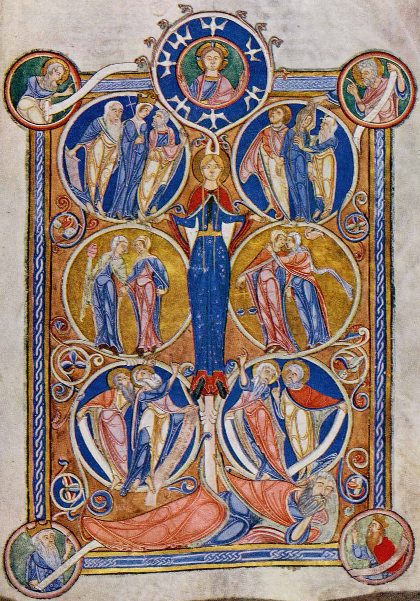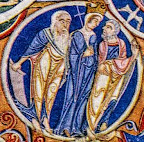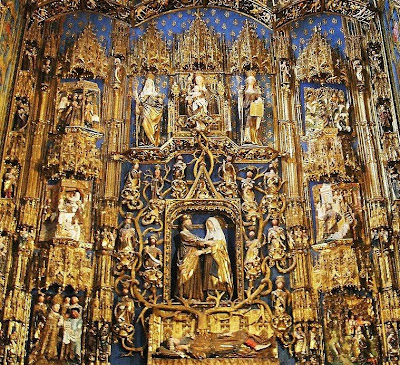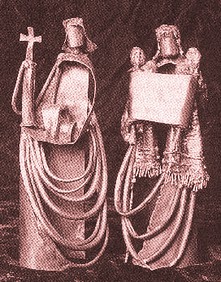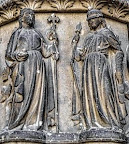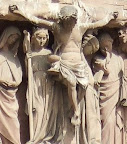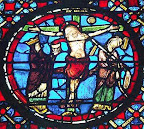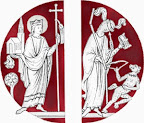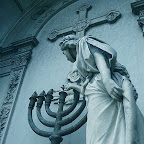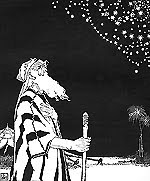The Significance of the Church Building. Even the staunchest opponents of sacred things, of sacred space in this case, accept the Christian community needs a place to meet, and on that basis they define the purpose of a church building in a non-sacral, strictly functional sense. Church buildings, they say, make it possible for people to get together for the liturgy. This is without question an essential function of church buildings and distinguishes them from the classical form of the temple in most religions. In the Old Covenant, the high priest performed the rite of atonement in the Holy of Holies. None but he was allowed to enter, and even he could do so only once a year. Similarly, the temples of all the other religions are usually not meeting places for worshippers, but cultic spaces reserved to the deity. The Christian church soon acquired the name
domus ecclesiae (the house of the Church, the assembly of the People of God), and then, as an abbreviation the word
ecclesia (“assembly,” “church”) came to be used, not just of the living community but also of the building that housed it. This development is accompanied by another idea: Christ himself offers worship as he stands before the Father. He becomes his members’ worship as they come together with him and around him. This essential difference between the Christian place of worship and the temples of other religions must not, of course, be exaggerated into a false opposition. We must not suggest a break in the inner continuity of mankind’s religious history, a continuity that, for all the differences, the Old and New Testaments never abolish. In his eighteenth catechesis (23-25), St. Cyril of Jerusalem makes an interesting point about the word
convocatio (
synagoge-ekklesia, the assembly of the people called together and made his own by God). He rightly points out that in the Pentateuch, when the word first makes its appearance with the appointment of Aaron, it is ordered towards worship. Cyril shows that this applies to all the later passages in the Torah, and, even in the transition to the New Testament, this ordering is not forgotten. The calling together, the assembly, has a purpose, and that purpose is worship. The call comes from worship and leads back to worship. It is worship that unites the people called together and gives their being together its meaning and worth: they are united in that “peace” which the world cannot give. This also becomes clear in relation to that great Old and New Testament archetype of the
ekklesia, the community on Sinai. They come together to hear God’s Word and to seal everything with sacrifice. That is how a “covenant” is established between God and man.
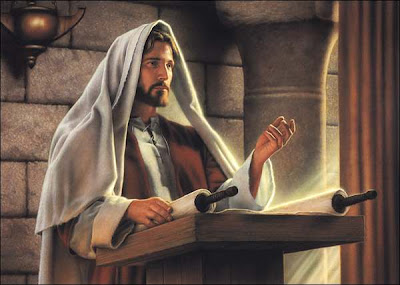 |
The word “orientation” comes from oriens, “the East.”
“Orientation” means “east-ing,” turning towards the east |
But instead of continuing with these theoretical considerations, let us look more closely at the process by which church buildings took concrete form. Using the research of E.L. Sukenik, Louis Bouyer has shown how the Christian house of God comes into being in continuity with the
synagogue and thus acquires a specifically Christian newness, without any dramatic break, through communion with Jesus Christ, the crucified and risen Lord. This close connection with the synagogue, with its architectural structure and liturgical form, does not in any way contradict what we said about the Christian liturgy not just continuing the synagogue but also incorporating the Temple. For the Jews saw the synagogue in relation to the Temple. The synagogue was never just a place for instruction, a kind of religious classroom, as Bouyer puts it. No, its orientation was always towards the presence of God. Now, for the Jews, this presence of God was (and is) indissolubly connected with the Temple. Consequently, the synagogue was characterized by two focal points. The first is the “seat of Moses,” of which the Lord speaks in the Gospel (cf. Mt 23:2). The rabbi does not speak from his own resources. He is not a professor, analyzing and reflecting on the Word of God in an intellectual way. No, he makes present the Word that God addressed and addresses to Israel. God speaks through Moses today. What the seat of Moses stands for is this: Sinai is not just a thing of the past. It is not mere human speech that is happening here. God is speaking.
 |
| Synagogue. A) Ark (Hechal or Aharon haKodesh) B) Small Teba (Lectern) from where the chazan leads the services C) Seats of the officers of the congregation D) Seats for men E) The greater Teba (raised platform) on which the Torah is read and the hakham delivers the sermon. Behind the greater Teba usually there are seats for the hakhamim: this seating is known as the Seat of Moses. |
The seat of Moses, then, does not stand for itself and by itself, nor is it simply turned towards the people. No, the rabbi looks—as does everyone else in the synagogue—toward the Ark of the Covenant, or rather the shrine of Torah, which represents the lost Ark. Up to the Exile, the Ark of the Covenant, was the only “object” allowed inside the Holy of Holies. That is what gave the Holy of Holies its special dignity. The Ark was seen as an empty throne, upon which the Shekinah—the cloud of God’s presence—came down. The cherubim—representing as it were, the elements of the world—served as “assistants at the throne.” They were not self-subsistent deities, but an expression of the created powers that worship the only God. God is addressed as “thou who art enthroned between the cherubim.” The heavens cannot contain him, but he has chosen the Ark as the “footstool” of his presence. In this sense, the Ark embodies something like the real presence of God among his own. At the same time it is an impressive sign of the absence of images from the liturgy of the Old Testament, which maintains God in his sovereignty and holds out to him, so to speak, only the footstool of his throne. During the Exile, the Ark of the Covenant was lost, and from then on the Holy of Holies was empty. That is what Pompeius found when he strode through the Temple and pulled back the curtain. He entered the Holy of Holies full of curiosity and there, in the very emptiness of the place, discovered what is special about biblical religion. The empty Holy of Holies had now become an act of expectation, of hope, that God himself would someday restore his throne.
 |
| Ark as Shrine of the Torah |
The synagogue, in its shrine of the Torah, contains a kind of Ark of the Covenant, which means it is the place of a kind of “real presence.” Here are kept the scrolls of the Torah, the living Word of God, through which he sits on his throne in Israel among his own people. The shrine is surrounded, therefore, with signs of reverence befitting the mysterious presence of God. It is protected by a curtain, before which burn the seven lights of the menorah, the seven-branch candlestick. Now the furnishing of the synagogue with an “Ark of the Covenant” does not in any way signify the local community has become, so to speak, independent, self-sufficient. No, it is the place where the local community reaches out beyond itself to the Temple, to the commonality of the one People of God as defined by the one God. The Torah is in all places one and the same. And so the Ark points beyond itself, to the one place of its presence that God chose for himself—the Holy of Holies in the Temple in Jerusalem. This Holy of Holies, as Bouyer puts it, remained the “ultimate focus of the synagogal worship” (p. 15). “Thus have all the synagogues, at the time of the Lord and since that time, have been oriented” (p. 15). The rabbi and the people gaze at the “Ark of the Covenant,” and in so doing, they orient themselves toward Jerusalem, turn themselves toward the Holy of Holies in the Temple as the place of God’s presence for his people. This remained the case even after the destruction of the Temple. The empty Holy of Holies had already been an expression of hope, and so, too, now is the destroyed Temple, which waits for the return of the Shekinah, for its restoration by the Messiah when he comes.
 |
| The Hurva Synagogue, Old City, Jerusalem |
The orientation towards the Temple, and thus the connection of the synagogue’s liturgy of the Word with the sacrificial liturgy of the Temple, can be seen in its form of prayer. The prayers said at the unrolling and reading of the scrolls of Scripture developed out of the ritual prayers originally linked to sacrificial actions in the Temple and now regarded, in accord with the tradition of the time without the Temple, as an equivalent of sacrifice. The first of the two great prayers of the synagogue rite comes to a climax in the common recitation of the Kiddush, of which the hymn of the seraphim in Isaiah chapter 6 and the hymn of the cherubim in Ezekiel chapter 3 are a part. Bouyer makes this comment: “But the truth must be that the association of men with these heavenly canticles, in the worship of the Temple, had probably been a central figure of the offering of the sacrifice of incense morning and evening of every day” (p. 22). Who would not be reminded of the Trisagion of the Christian liturgy, the “thrice holy” hymn at the beginning of the Canon? Here the congregation does not offer its own thoughts or sharing in the cosmic song of praise of the cherubim and seraphim. The other great prayer of the synagogue culminates in “the recitation of the
Abodah which, according to the rabbis, was formerly the consecration prayer of the daily burnt offering in the Temple” (p. 22). The petition added to it about the coming of the Messiah and the final restoration of Israel may be seen “as the expression of the essence of the sacrificial worship” (p. 22). Let us remind ourselves here of that transition from animal sacrifices to “worship in harmony with the
logos” which characterizes the path from the Old Testament into the New. Finally, we must mention the fact that no special architectural form was created for the synagogue. The “typical Greek building for public meetings: the basilica,” was used (p. 17). Its aisles, divided off by rows of columns, enabled people entering the building to circulate around it.
 |
| Tell Hum Synagogue, Galilee |
I have lingered over this description of the synagogue because it exhibits already the essential and constant features of Christian places of worship. Once again we see clearly the essential unity of the two Testaments. Not surprisingly, in Semitic, non-Greek Christianity, the original form of church buildings generally retains the close connection of church with synagogue, a pattern of religious continuity and innovation. (I am thinking here of the Monophysite and Nestorian Churches of the Near East, which broke away from the Church of the Byzantine Empire during the Christological debates of the fifth century.) Christian faith produced three innovations in the form of the synagogue as we have just sketched it. These give Christian liturgy its new and proper profile. First of all, the worshipper no longer looks towards Jerusalem. The destroyed Temple is no longer regarded as the place of God’s earthly presence. The Temple built of stone has ceased to express the hope of Christians; its curtain is torn forever. Christians look toward the east, the rising sun. This is not a case of Christians worshipping the sun but of the cosmos speaking of Christ. The song of the sun in Psalm 19(18) is interpreted as a song about Christ when it says, “[The sun] is coming forth like a bridegroom leaving his chamber. …Its rising is from the end of the heavens, and its circuit to the end of them” (vv. 5f.). This psalm proceeds directly from applauding creation to praising the law. Christians interpret it in terms of Christ, who is the living word, the eternal Logos, and thus the true light of history, who came forth in Bethlehem from the bridal chamber of the Virgin Mother and now pours out his light on all the world. The east supersedes the Jerusalem Temple as a symbol. Christ, represented by the sun, is the place of the Shekinah, the true throne of the living God. In the Incarnation, human nature truly becomes the throne and seat of God, who is thus forever bound to the earth and accessible to our prayers. In the early Church, prayer towards the east was regarded as an apostolic tradition. We cannot date exactly when this turn to the east, the diverting of the gaze from the Temple, took place, but it is certain that it goes back to the earliest times and was always regarded as an essential characteristic of Christian liturgy (and indeed of private prayer). This “orientation” of Christian prayer has several different meanings. Orientation is, first and foremost, a simple expression of looking to Christ as the meeting place between God and man. It expresses the basic Christological form of our prayer.
[...] The second innovation in regard to the synagogue is as follows. A new element has appeared that could not exist in the synagogue. At the east wall, or in the apse, there now stands an altar on which the Eucharistic Sacrifice is celebrated. As we saw, the Eucharist is an entry into the liturgy of heaven; by it we become contemporaries with Jesus Christ’s own act of worship, into which, through his Body, he takes up worldly time and straightaway leads it beyond itself, snatching it out of its own sphere and enfolding it into the communion of eternal life. Thus the altar signifies the entry of him who is the Orient into the assembled community and the going out of the community from the prison of this world through the curtain now torn open, a participation in the Pasch, the “passing over” from the world to God, which Christ has opened up. It is clear that the altar in the apse both looks towards the Oriens and forms part of it. In the synagogue the worshippers looked beyond the “Ark of the Covenant,” the shrine of the Word, towards Jerusalem. Now, with the Christian altar, comes a new focal point. Let us say again: on the altar, where the Temple had in the past foreshadowed, is now present in a new way. Yes, it enables us to become the contemporaries of the Sacrifice of the Logos. Thus it brings heaven into the community assembled on earth, or rather it takes that community beyond itself into the communion of saints of all times and places. We might put it this way: the altar is the place where heaven is opened up. It does not close off the church, but opens it up—and leads into the eternal liturgy. We shall have more to say about the practical consequences of the Christian altar, because the question of the correct position for the altar is at the center of postconciliar debate.
But first we must finish what we were saying about the different ways in which Christian faith transformed the synagogue. The third point to be noted is that the shrine of the Word remained, even with regard to its position in the church building. However, there is a fundamental innovation here. The Torah is replaced by the Gospels, which alone can open up the meaning of the Torah. “Moses,” says Christ, “wrote of me” (Jn 5:46). The shrine of the Word, the “Ark of the Covenant,” now becomes the throne of the Gospel. The Gospel does not, of course, abolish the “Scriptures,” nor push them to one side, but rather interprets them, so that henceforth and forever they form the Scriptures of Christians, without which the Gospel would have no foundation. The practice in the synagogue of covering the shrine with a curtain, in order to express the sacredness of the Word, is retained. Quite spontaneously, the new, second holy place, the altar, is surrounded by a curtain, from which, in the Eastern Church, the Iconostasis develops. The fact that there are two holy places had significance for the celebration of the liturgy. During the Liturgy of the Word, the congregation gathered around the shrine of the Sacred Books, or around the seat associated with it, which evolved quite spontaneously from the seat of Moses to the bishop’s throne. Just as the rabbi did not speak by his own authority, so the bishop expounds the Bible in the name, and by the mandate, of Christ. Thus, from being a written word from the past, it again becomes what it is: God’s addressing us here and now. At the end of the Liturgy of the Word, during which the faithful stand around the bishop’s seat, everyone walks together with the bishop to the altar, and now the cry resounds: “
Conversi ad Dominum,” Turn towards the Lord! In other words, look towards the east with the bishop in the sense of the words from the epistle to the Hebrews: “[Look] … to Jesus the pioneer and perfecter of our faith” (12:2). The Liturgy of the Eucharist is celebrated as we look up to Jesus. It is our looking up to Jesus. Thus, in early church buildings, the liturgy has two places. First the Liturgy of the Word takes place at the center of the building. The faithful are grouped around the
bema, the elevated area where the throne of the Gospel, the seat of the bishop and the lectern are placed. The Eucharistic celebration takes place in the apse, at the altar, where the faithful “stand around.” Everyone joins with the celebrant in facing east, towards the Lord who is to come.
 |
| Bema of the Touro Synagogue |
Finally, we must mention one last difference between the synagogue and the earliest church buildings. In Israel, only the presence of men was deemed to be necessary for divine worship. The common priesthood described in Exodus chapter 19 was ascribed to them alone. Consequently, in the synagogue, women were only allowed into the tribunes or galleries. As far as the apostles were concerned, as far as Jesus himself is concerned, there was no such discrimination in the Church of Christ. Even though the public Liturgy of the Word was not entrusted to women, they were included in the liturgy in the same way as men. And so now they had a place—albeit in separation from men—in the sacred space itself, around both the
bema and the altar.
Joseph Ratzinger,
The Spirit of the Liturgy, San Francisco: Ignatius Press, 2000, pt. 2, chap. 2, pp. 62-73; "Sacred Places: The Significance of the Church Building,"
Sacred Architecture Journal, Vol. 10, 2005 (
source).


